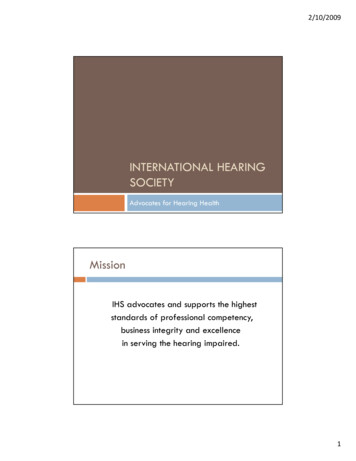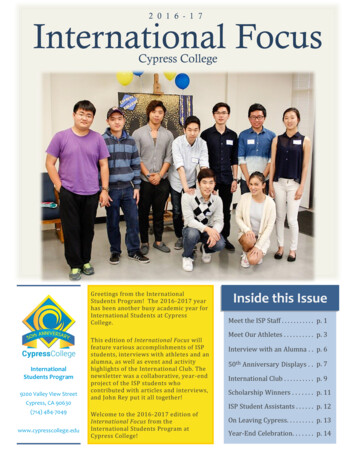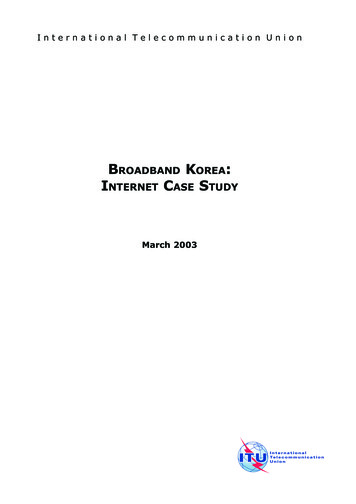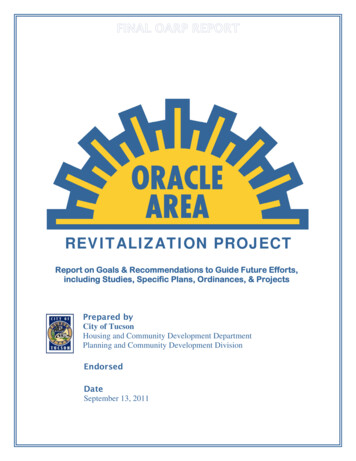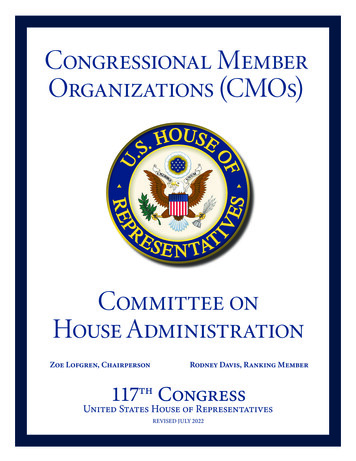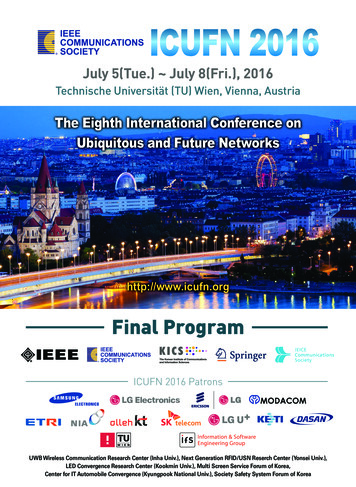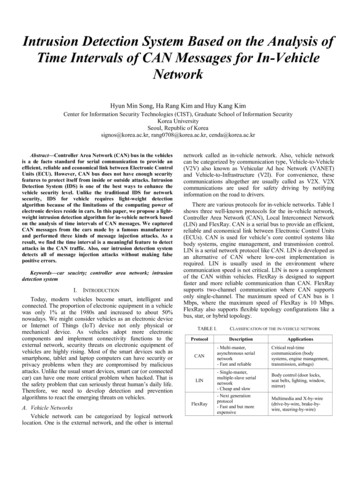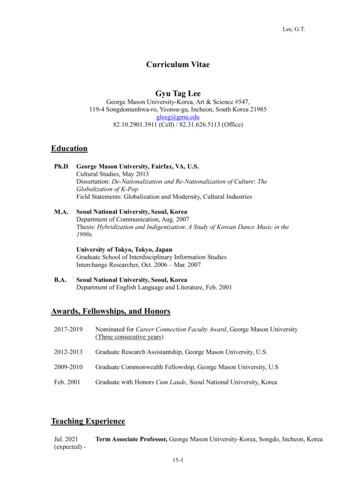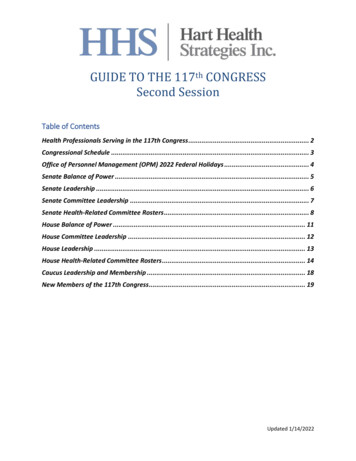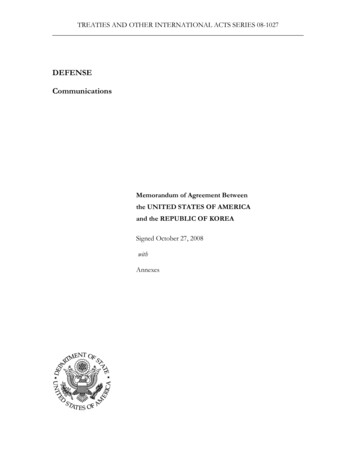
Transcription
TREATIES AND OTHER INTERNATIONAL ACTS SERIES 08-1027DEFENSECommunicationsMemorandum of Agreement Betweenthe UNITED STATES OF AMERICAand the REPUBLIC OF KOREASigned October 27, 2008withAnnexes
NOTE BY THE DEPARTMENT OF STATEPursuant to Public Law 89—497, approved July 8, 1966(80 Stat. 271; 1 U.S.C. 113)—“. . .the Treaties and Other International Acts Series issuedunder the authority of the Secretary of State shall be competentevidence . . . of the treaties, international agreements other thantreaties, and proclamations by the President of such treaties andinternational agreements other than treaties, as the case may be,therein contained, in all the courts of law and equity and of maritimejurisdiction, and in all the tribunals and public offices of theUnited States, and of the several States, without any further proofor authentication thereof.”
REPUBLIC OF KOREADefense: CommunicationsMemorandum of agreement signedOctober 27, 2008;Entered into force October 27, 2008.With annexes.
MEMORANDUM OF AGREEMENTBETWEENUNITED STATES DEPARTMENT OF DEFENSEANDREPUBLIC OF KOREA MINISTRY OF NATIONAL DEFENSECONCERNINGCOMMUNICATIONS INTEROPERABILITY AND SECURITYPARAGRAPH IThis Memorandum of Agreement (MOA) is entered into between the United States (US)Department of Defense (DoD) and the Republic of Korea (ROK) Ministry ofNational Defense(MND), referred to as the Sides, in furtherance of the mutual security interests of the US and theROK, and to promote communications interoperability and security between their respectiveArmed Forces.PARAGRAPH IIThe purposes ofthis MOA are to promote tactical communications (comms) systems .interoperability between the Armed Forces of the US and ROK; to define policies relating toConfiguration Management (CM) of interoperable communications systems, to include SpreadSpectrum communications systems, testing thereof, and maintenance of Procedural andTechnical Standards; and to provide for secure comms interoperability between the Sides throughthe provision by DoD of Communications Security (COMSEC) Equipment and Services to MNDto protect classified and sensitive national security information and data. The specific policiesand procedures addressing each Side's responsibilities under this MOA are set forth in theattached Annexes A and B which form an integral part of this MOA.PARAGRAPH IIIEach Side will carry out its activities under this MOA in accordance with its respective nationallaws. Financial commitments under this MOA are subject to the availability of funds authorizedand appropriated for such purposes by the respective governments.PARAGRAPH IVThe standards and baseline documents identified at Appendix 1 of Annex A to this MOA andchanges to those standards and documents which support CM responsibilities outlined in thisMOA and in Annex A will be protected in accordance with the provisions of Annex A.PARAGRAPHVMND will bear the cost of reconfi g its comm systems to achieve or maintain combinedUS/ROK Armed Forces interoJ?erability. Each Side will bear its own costs of participating incombined testing, as agreed, With each Side being responsible for the costs associated with itsportion of the testing. MND will reimburse DoD for any testing assistance that it requests, otherthan official combined interoperability tests, through Foreign Military Sales (FMS) procedures.
. ,.'.PARAGRAPH VISubject to United States Government (USG) release approvals, DoD will provide DoDCOMSEC equipment, keying and other materials, and support services to MND in order tosatisfy requirements for secure interoperability between US Armed Forces through one or moreof the following means as mutually agreed:a. FMS procedures will be used to provide by sale or lease COMSEC equipment, keyingand other materials, or support services. Procurement through FMS procedures will be pursuantto Letters of Offer and Acceptance (LOA) and in accordance with the Arms Export Control Act.In the event of any inconsistency between an LOA and this MOA, the LOA will take precedence.b. Other authorized means, as determined by DoD, may be used to provide COMSECequipment or materials including keying materials, in order to satisfy short-term DoD/MNDsecure interoperability requirements.PARAGRAPH VIIThe DoD and MND will establish and operate separate DoD COMSEC accounts dedicated toDoD COMSEC equipment and services provided to the MND. These COMSEC accounts willperform central receiving, temporary storage, and transfer services for DoD-provided COMSECequipment, documents, and keying material. The DoD COMSEC account will deliver COMSECequipment and make bulk deliveries ofMND keying material to the MND COMSEC accountand assist in the further distribution of the matenal toROK Services; train MND personnel in theproper custodianship and safeguarding of DoD-provided COMSEC equipment and keyingmaterial; and conduct periodic inventories and inspections of DoD-provided COMSEC. TheMND will establish, man, furnish, operate, support and sustain the MND COMSEC account todistribute, manage, and control keying material and COMSEC equipment under the DoDCOMSEC account's oversight. The details to implement this PARAGRAPH will be establishedin a separate Annex to this CISMOA.PARAGRAPH VIIIDoD-provided COMSEC equipment, keying and other materials, and services will be for theexclusive use ofMND. DoD-provided COMSEC equipment, keying and other materials, or thedetails of DoD-provided support services, will not be transferred to or revealed in any manner toa third party without the prior written consent of the USG. DoD-provided COMSEC equipmentand materials, including keying materials, will be safeguarded and accounted for in accordancewith the procedures prescribed in the current edition of "Safeguarding COMSEC Material andFacilities", (NAG-14 series). NAG-14 establishes the minimum physical security requirementsfor the handling and safeguarding of classified COMSEC equipment and material.PARAGRAPH IXDoD-provided COMSEC equipment and materials, including keying materials, will beinstalled and maintained only by authorized US personnel. Th1s does not preclude, duringperiods of operational necessity, the one-for-one replacement of malfunctioning equipment byMND personnel. When authorized by the US, qualified ROK personnel may remove and/orreplace US COMSEC equipment previously installed by US personnel. For purposes of2
'·performing required maintenance and periodic inspections, authorized and duly identified USpersonnel will be permitted timely access to DoD-provided COMSEC equipment and material.DoD will, in cases when time and circumstances permit, notify MND in advance in thoseinstances when access by authorized US personnel is considered necessary. During periods ofsuch access, US personnel will be accompanied by appropriately cleared MND personnel. Thisdoes not preclude inspections by MND, which may be performed at any time.PARAGRAPH XOnly DoD-provided COMSEC keying materials will be used with DoD-provided COMSECequipment. Only DoD-provided keying materials will be used for DoD/MND bilateralinteroperability and for DoD-approved multinational networks involving DoD, MND, and thirdparties. DoD-provided COMSEC equipment and materials, including keying materials, will notbe subject to any cooperative development, co-production, co-assembly or production licensingagreements.PARAGRAPH XIDisagreements or disputes between the Sides arising under or relating to the terms,interpretation, or application of this MOA, or any subsequent modification(s), will be resolvedsolely through mutual consultation between the Sides at the lowest feasible level and will not bereferred to any international tribunal or to a third party or persons or entities for resolution orsettlement.PARAGRAPH XIIThis MOA may be amended in writing as mutually agreed and executed by authorizedrepresentatives of the DoD and the MND. Such amendments will be dated, consecutivelynumbered, and appended to each copy of this document.PARAGRAPH XIIIUpon completion ofthe negotiations and/or documentation required pursuant to PARAGRAPHVII of this MOA, this MOA will supersede any temporary loan or other agreements forCOMSEC support made previously between individual services of DoD and MND.Commitments of the Sides concerning security measures, restrictions on use and transfer ofequipment, materials including keying materials, or services, and protection of proprietaryinformation will continue irrespective of termination of this MOA or any previous agreements.LOAs and other implementing transactions will be terminated in accordance with their terms.PARAGRAPH XIVThis MOA will be written and signed in two languages, English and Korean. Each will haveequal effectiveness with the respective English and Korean texts certified by official translatorsto be in agreement. This MOA will enter mto force on the date of the last signature and willremain in force for 15 years unless earlier terminated upon six months written notice by one Sideto the other Side.3
··,·For theDepartment of Defense,Umted States of AmericaFor theMinistry ofNational Defense,Repubhc of KoreaRONALD M. BOUCHARDBrigadier General, US ArmyDirector, Communications SystemsUS Pacific CommandLEEGYUSANGMajor General, ROK ArmyDirectorC4 DirectorateDate: 7 t!:i 2-eJo Date:4
ANNEX A TO MEMORANDUM OF AGREEMENT BETWEEN US DOD/ROK MNDCONCERNING COMMUNICATIONS INTEROPERABILITY AND SECURITYSUBJECT: CONFIGURATION MANAGEMENT OF TACTICAL COMMAND ANDCONTROL COMMUNICATIONS STANDARDSSECTION IGENERAL POLICIES AND PROCEDURES1. The Sides will use US Standards to define interoperability parameters. Baseline documentsfor standards are defined in Appendices 1 and 2 of this Annex. Provision of technicalinformation or data by the DoD will be subject to US releasability requirements.2. The Sides will form a technical cooperation group, called the Command and ControlInteroperability Board (CCIB). The CCIB will review proposed tactical comms systemsinteroperability change proposals to the defined baseline standards. The Sides will be equallyrepresented on the CCIB. Meetings will be held at least annually at a mutually acceptablelocation. The Sides will alternate chairmanship of the CCIB.3. The CCIB will determine combined interoperability req uirements; develop standards andprocedures to satisfy interoperability requirements; determme information to be exchanged tosupport combined comms interoperability, to include spread spectrum issues and systems;determine appropriate training on approved standards; oversee implementation of approvedstandards; and ensure the maintenance of approved standards through the application ofConfiguration Management (CM).4. The Sides will review any proposed change to the defined procedural standards, as well as tobaseline technical standards, prior to adoption of such change. Mutual approval is necessaryprior to adoption of any change that may affect interoperability. However, MND agrees that USor allied-originated and US approved changes to these standards will be incorporated by ROKMND ifROK MND and US DoD agree the changes are necessary to ensure continuedinteroperability.5. A Terms of Reference (TOR) document will be prepared and agreed to by the CCIB. TheTOR will provide specific roles, responsibilities, organizational relationships, methods of work,and taskings of the CCIB in support of this MOA.6. The CCIB will plan, coordinate, and evaluate required testing. Test results will be reviewedby the CCIB along with a test report prepared by the designated test organization. After testing iscomplete, the CCIB will recommend appropriate action based on the test results.7. Subject to availability of personnel and resources and subject to authorized use of appropriateFMS cases if required, the S1des will designate office(s) responsible for combined testmg;provide systems and personnel necessary to participate in testing in accordance with agreed-toschedules and test plans; fund respective portions of combined testing costs; and implementchanges, as required, based on test results.8. The CCIB will identify the configuration baseline and management documentation that willrequire maintenance and updates as a result of the CM process; provide procedural, technical,and operational evaluations on all Interface Change Proposals (ICPs); ensure the ICPs areincorporated in appropriate baseline of management documentation; determine the necessity fortesting changes and the extent of testing reqmred; recommend approval or disapproval ofiCPs tothe appropriate MND and DoD authorities; ensure that agreed ICPs are incorporated in5
appropriate baseline or management documentation; establish and maintain a configuration statusaccounting system to track the status ofiCPs; and, monitor reports of the use ofinteroperabilitystandards by operating forces, in order to identify issues requiring corrective action.9. The Sides will apply combined CM to defined procedural standards and technical standards.The Sides will designate an office responsible for CM; provide qualified personnel to participatein the CCIB; review change proposals and analyze test results; screen all hardware and softwarechanges to participating systems for possible applicability as changes; submit change proposalsas required; provide facilities and test units for mteroperability and testing; participate in testsand analyze test results in accordance with test plans, procedures, and schedules to be decided bythe CCIB; and provide national positions on changes to those procedures and standards that havemultinational interoperability impacts. Data and lessons learned as a result of testing will beprovided to the other Side and action required as a result of testing will be taken by each Sidepursuant to the terms of this MOA.10. The level of classification of information or data provided in implementation of this MOAwill not be higher than SECRET. The ROK MND w1ll ensure that information or data providedunder the terms of this MOA will be safeguarded and afforded protection commensurate withprescribed US procedures and standards.11. Information or data will not be used for the purposes of manufacturing or production ofequipment without the prior written consent of the originating Side. Proprietary information ordata will not be used or disclosed in any manner that will preJudice the owner's rights in suchinformation or data.12. The originating Side will identify any information or data provided under the terms of thisagreement that is subject to limited nghts of use. Information or data subject to limited rights ofuse or disclosure will not be released to third parties without prior written consent of theoriginating Side.13. Information or data provided under this agreement will not be disclosed to any othergovernment, individual organization, or third party, including contractors, without the consent ofthe originating Side.14. Receipts will be obtained for all classified information provided; copies of receipts for USclassified mformation will be furnished to the sponsoring service or agency.15. Nothing in this MOA diminishes or limits any rights that either Side may have acquired inpatents, technical data, or copyrights under any other agreements.6
.APPENDIX 1 TO ANNEX A, CONFIGURATION MANAGEMENT OF TACTICALCOMMAND AND CONTROL COMMUNICATIONS STANDARDS, MEMORANDUM OFAGREEMENT BETWEEN US DOD/ROK MND CONCERNING COMMUNICATIONINTEROPERABILITY AND SECURITYSUBJECT: CONFIGURATION DOCUMENTATIONDocumentation under Configuration Management ofthe US/ROK Command and ControlInteroperability Board (CCIB) is an ongoing Agenda Item for those meetings. The attached is abaseline list of mutually-identified and agreed combined configuration items (Cis) for proceduralinterface standards, as well as other documentation, that are subject to configuration managementwithin the CCIB. This baseline will evolve and the most current list will be included as theUS/ROK DOCUMENT STATUS REPORT in the official minutes to the CCIB meetings.INITIAL BASELINE DOCUMENTSCPICKMOACOMSECMOUCMMOUCM MOU (ANNEX A, B, C)TORCMPLANCITP 3014 (K)MIL-STD-6011JMTOP (D)JMTOP (B)MIL-STD-6040MTF User FormatsMIL-STD-6016(C) Change 1MIL-STD-2525 (B), CH 16 Dec 198415 Jul199323 Apr 9823 Apr 9820 May 03I3 Sep 93I6 May OII Aug 02I6 Oct 06I Oct 033I Mar 0631 Mar 06Aug02MIL-STD 60I7MIL-STD 60I7 Version AJuly 20051 Mar 0419 Jul 06Joint Tactical Data LinkManagement Plan (JTDLMP)CISMOAMIL-STD-6020MIL-STD 3011MIL-STD 6011B ICPsMIL-STD 6011C ICPsUSMTF TRAINING TUTORIAL CDROMNAG-14/NAG-181 Jun 00DRAFT1 Mar 0430 Sep 0214 Nov 0514 Nov 0514 Nov 059 May 057
APPENDIX 2 TO ANNEX A, CONFIGURATION MANAGEMENT OF TACTICALCOMMAND AND CONTROL COMMUNICATIONS STANDARDS, MEMORANDUM OFAGREEMENT BETWEEN US DOD/ROK MND CONCERNING COMMUNICATIONINTEROPERABILITY AND SECURITYSUBJECT: DEFINITIONS1. Baseline Documentation. Document(s) formally designated and fixed at a specific timeduring the life cycle of a configuration item. The document constitutes a basehne where changesmust first be approved through an established CM process. Applicable documents include butare not limited to:a. Tactical Command and Control Communications Systems Standards. MIL-SID 6011C(formerly Joint Pub 6-01) contains Joint Tactical Air Operations message standards for TacticalData Links (TDL) A and B, and MIL-SID 6016C contains message standards for TDL J toachieve compatibility and interoperability between tactical command and control systems. Allchanges and updates to MIL-SID 6011C and 6016C will be provided to MND. MIL-SID 6040(formerly Joint Pub 6-04) contains US Message Text Format (USMTF) record and voicemessage standards for achieving compatibility and interoperability between tactical forces andsystems using a message format that 1s both man and machine readable. All releasable changesand updates to MIL-SID 6040 will be provided to MND.b. Standard Operating Procedures. Provides system compatibility information anddetailed functional descriptions and procedures used by operators for establishing andmaintaining a procedural standards interface. These documents will be either US Joint Serviceapproved and/or NATO approved Standard Operating Procedures.c. Applicable spread spectrum technical standards baseline documents will be identified asan update when MND requests are forwarded to DoD for foreign release approval.2. Bit-Oriented Messages (BOMs). Messages that are structured in binary digits, restrictingthem to machine interpretation since composition and readability by humans requires translationaids. M-Series messages, VIR-Series messages and J- series messages used in TDLs A, B, C andJ are examples ofBOMs.3. Change Proposalsa. A change proposal recommends a change to the baseline documentation of a standard(e.g., a data link, or data link system implementation of a Technical Interface Specification).Change proposals will be processed according to the procedures agreed upon in the TORdocument for the CCIB. The Configuration Management Plan will define the change proposalformat requirements and submission process.b. Interface Change Proposal (ICP). A document used to propose a change to proceduralinterface standards documents and management documents that are placed under CM. As aminimum, an ICP will contain an analysis of impact from the perspective ofthe submittingnation.4. Configuration Management (CM). A discipline applying technical and administrativedirection and oversight to identify and document the functional and physical characteristics ofconfiguration items (Cis); audit the Cis to verify conformance to specifications, interface controldocuments, and other contract requirements; control changes to Cis and their relateddocumentation; and record and report information needed to manage Cis effectively.8
5. Message Text Format (MTF). A specified sequence of main text set formats having a uniquemessage text format identifier. Formatted messages can be used for voice or record trafficpurposes and are intended to be both man and machine readable. MTFs implemented for US useare called USMTFs and are documented in MIL-STD 6040.6. Procedural Interface Standard. Specifications for the manner of accomplishing the exchangeof information across an interface. It defines: (a) the form or format in which information is tobe exchanged; (b) the prescribed information exchange language, syntax, and vocabulary to beused in the information exchange; (c) interface operating procedures that govern the informationexchange.7. Tactical Data Link (TDL). A US Joint Staff-approved standardized communications linksuitable for transmission of digital information via BOMs, i.e., a joint data link. A TDL ischaracterized by standardized message formats and transmission characteristics.a. TDL A. A half-duplex secure netted digital data link utilizing parallel transmissionframe characteristics and standard message formats at either 1364 or 2250 bits per second.b. TDL B. A full-duplex secure point-to-point data link utilizing serial transmission framecharacteristics and standard message formats at 1200 bits persecond.c. TDL C. A half-duplex digital data link utilizing serial transmission framecharacteristics and standard message formats at 5000 bits per second.d. TDL J. A secure, high capacity, jam resistant, nodeless data link which uses the JointTactical Distribution System (JTIDS) or Multifunctional Information Distribution System(MIDS) transmission characteristics and the protocols, conventions, and fixed-length messageformats defined by the MIL STD 6016 message standard.8. Technical Interface Specification (TIS). A document intended primarily for use in definingtechnical interface characteristics of C3 systems or equipment employed in joint or combinedtactical operations. Establishes the basehne documentation for configuration management of C31systems and equipment interoperability. Describes essential technical requirements that must bemet to provide interoperability. Establishes design parameters that will ensure interoperabilityrequirements in tactical C3 employments.9. Technical Interface Standards. Specifications of the functional, electrical, and physicalcharacteristics necessary to allow the exchange of information across an interface betweendifferent tactical comm systems or equipment.10. Testing. Testing during the life cycle of the interface standards assures that interoperabilityis maintained. Two types of testing are normally required:a. Operational Maintenance Testing. Tests conducted to ensure that MND systemsimplementing the procedural and technical standards are interoperable with US systems. Thesetests will evaluate the degree of interoperability that has been achieved through theimplementation of the standard by participating comm systems.b. Requalification Testing. Tests conducted to ensure that systems remain compatibleand interoperable following system software changes or additions directly associated w1th theimplementation of these procedural and technical standards.9
ANNEX B TO MEMORANDUM OF AGREEMENT BETWEEN US DOD/ROK MNDCONCERNING COMMUNICATIONS INTEROPERABILITY AND SECURITYSUBJECT: PROVISION OF COMMUNICATIONS SECURITY EQUIPMENT ANDSERVICESRESPONSIBILITIES OF THE SIDES1. The US Department of Defense (DoD) will:a. Provide releasable and approved DoD COMSEC equipment, keying and othermaterials, and services to the MND in accordance with PARAGRAPH VI of this MOA in orderto satisfy mutually identified US/ROK Armed Forces requirements for secure commsinteroperability.b. Support the MND COMSEC account in accordance with the terms of PARAGRAPHVII ofthis MOA. Such support will include: (1) orienting MND personnel to proceduresrequired to operate, safeguard, and account for DoD-provided COMSEC equipment and materialin accordance with PARAGRAPH VII ofthis MOA; (2) providing or arranging for theinstallation and maintenance of DoD-provided COMSEC equiJ?ment in accordance withPARAGRAPH IX ofthis MOA, and; (3) inspecting DoD-provided COMSEC equipment andmaterials periodically to ensure that they are being handled, used, and safeguarded m accordancewith prescribed DoD procedures and standards in accordance with PARAGRAPH VIII of thisMOA.2. The ROK MND will:a. Ensure that DoD-provided COMSEC equipment and materials including keyingmaterials are safeguarded and afforded protection commensurate with prescribed DoDprocedures and standards in accordance with PARAGRAPHs VII through X ofthis MOA.b. Provide the funding required to establish, operate and sustain a ROK MND COMSECaccount dedicated to the eqmpment and services provided by the DoD to the MND in accordancewith PARAGRAPH VII ofthis MOA.c. Establish a centralized system to distribute and account for DoD-provided COMSECequipment and materials including keying materials in accordance with PARAGRAPH VII ofthis MOA.d. In accordance with PARAGRAPH VIII ofthis MOA, ensure that DoD-providedCOMSEC equipment and materials including keying materials are used only for mutuallyidentified US/ROK Armed Forces secure interoperability requirements, and that such equipmentand materials are not revealed in any manner to or transferred to a third party unless authorizedby the US DoD.e. In accordance with PARAGRAPH X ofthis MOA, ensure that only keying materialsprovided by the DoD are used with DoD-provided COMSEC equipment.f. In accordance with PARAGRAPH IX ofthis MOA, arrange for access by authorizedand duly identified US personnel to DoD-provided COMSEC equipment and materials includingkeying materials for necessary maintenance and periodic inspectiOns.g. Ensure that safeguard procedures established in accordance with PARAGRAPH VIII ofthis MOA include requirements that emergency destruction procedures are implemented in those10
instances where loss or compromise of DoD-provided COMSEC equipment or material appearsimminent and that DoD authorities are notified in the most expeditious manner possible of anyloss or suspected compromise of DoD-provided COMSEC equipment or material.h. Provide English speaking personnel to ensure that US COMSEC facilities day to dayoperations are conducted in English and to act as translators to support the US COMSECpersonnel day to day operations.i. Provide an English speaking escort when US personnel have a requirement to travel toROK facilities housing COMSEC material and equipment. MND will allow US personnelaccess to these facilities for such purposes as maintaining, inspecting, and inventorying USprovided COMSEC material and eCJ.uipment. Such access will be permitted within the scope andunder guidance provided by the designated ROK personnel.j. Return all COMSEC equipment, associated materials, destruction certificates, and SF153's m a timely manner as agreed upon between ROK and US, upon notification by USpersonnel, and upon deactivatiOn of system or upon termination of this agreement.3. The Sides will negotiate, agree to, and record the special terms and conditions for each specificDoD/MND COMSEC equipment, modification, and services project. These terms and conditions will bedocumented in FMS LOAs, or Appendices, and will be appended to this MOA in order to provide arecord for the Sides of the COMSEC transactions and commitments between them.4. In the past, t! e.!- tJ I(Ton Sin-Bo-Ahn-Jang-Be) was used to refer to both ROK andUS COMSEC; however, the term, t! e.!- tJI (Tong-Sin-Bo-Ahn-Jang-Be) is no longer usedby the RQK military to describe COMSEC. KDI has. mstructed the ROK to use"2:1 gg,t- 2. tli(Yun-Hap-Ahm-Ho-Jang-Be)" to Identify US produced COMSEC and" Hg,t- 2. tli(Kuk-San-Ahm-Ho-Jang-Be)" to identify ROK produced COMSEC. With theint nt of maintaining clarity, the US and ROK have a reed to use the Hangul terme:! g g,t- 2. tJ I(Yun-Hap-Ahm-Ho-Jang-Be) to descnbe US produced COMSEC released to theROK.11
APPENDIX 1 ANNEX B, PROVISION OF COMMUNICATIONS SECURITY EQUIPMENTAND SERVICES, MEMORANDUM OF AGREEMENT BETWEEN US DOD/ROK MNDCONCERNING COMMUNICATIONS INTEROPERABILITY AND SECURITYSUBJECT: EQUIPMENT AND SERVICES TRANSITION1. COMSEC and Controlled Cryptographic Items (CCI) equipment originally released to theROK at no cost for use will continue to be provided at no cost for use, with the exception of anycurrent and future sustainment, maintenance, and replacement. COMSEC and CCI equipmentoriginally released to the ROK at no cost for use continues to remain the property of the US andthe ROK will abide by all applicable security requirements identified in th1s MOA.12
CONCERNING COMMUNICATIONS INTEROPERABILITY AND SECURITY SUBJECT: CONFIGURATION MANAGEMENT OF TACTICAL COMMAND AND CONTROL COMMUNICATIONS STANDARDS SECTION I GENERAL POLICIES AND PROCEDURES 1. The Sides will use US Standards to define interoperability parameters. Baseline documents for standards are defined in Appendices 1 and 2 of this Annex .

